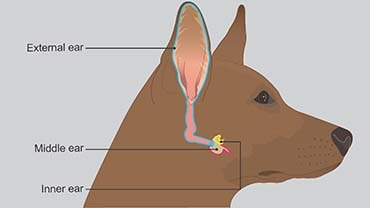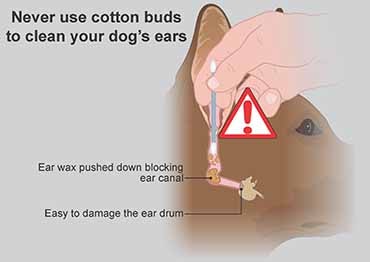Ear infections in dogs
Overview
- An ear infection is an irritating and painful overgrowth of bacteria or yeast in the ear canal, usually caused by an underlying condition such as ear mites, a skin problem, or excess earwax.
- Ear scratching, pain and head shaking are all common symptoms of an infection.
- A head tilt or loss of balance is a sign your dog’s infection has moved deeper into the ear.
- Contact your vet if you suspect your dog has an ear infection. The quicker your dog is treated, the faster their recovery is likely to be.
General information
An ear infection is an irritating and painful overgrowth of bacteria or yeasts inside the ear. Most ear infections develop due to an underlying problem such as a skin allergy, ear mites, growths, excessive ear cleaning or wax.
Most ear infections only affect the outer ear canal, but left untreated, an infection can spread deeper down into the middle or inner ear.

Structure of a dog’s ear. Click image to enlarge.
Symptoms
Symptoms of an ear infection include:
- Head shaking
- Face/head rubbing (often along the ground)
- Itchy/painful ear(s)
- Redness, swelling, heat
- A smelly or pussy discharge
- An aural haematoma (swelling in the ear flap)
- Scabs and crusting in the ear and side of their face.
Middle and inner ear infections also often cause:
- A head tilt to one side
- Loss of balance
- Vomiting
- Partial deafness.
When to contact your vet
Contact your vet for an appointment ASAP if you suspect your dog has an ear infection - it’s a very painful problem that needs prompt treatment. If you notice any signs of a middle or inner ear infection (loss of balance/head tilt), this is more serious and requires a same-day appointment. Be sure to tell your vet if your dog has regular ear infections or has had more than 2-3 in its lifetime.
Find out whether you are eligible for free or low cost PDSA veterinary treatment using our checker.
Treatment
Your vet may want to look at a discharge sample from the infected ear to find the cause, and then recommend some of the following:
- Eardrops. Medicated eardrops containing antibiotics, antifungals (to kill yeasts) and anti-inflammatories help to clear swelling and pain. Make sure you finish the whole course of drops (even if your dog’s ears seem better after a couple of days).
- Ear cleaning. It’s important to keep the inside of your dog’s ears clean while they heal. Your vet will advise you how to do this and which product to use. Never use cotton buds.
- Anti-inflammatory pain relief. If your dog is in a lot of pain, your vet may prescribe anti-inflammatory pain relief as well as eardrops.
- Antibiotic tablets. If your dog has a very severe infection, they may need antibiotic tablets as well as eardrops. However, eardrops are usually sufficient.
- Treating the underlying cause. Most ear infections are caused by an underlying condition for example allergic skin disease. It’s just as important to treat the underlying cause as it is to treat the infection itself because untreated, the infection will keep coming back.

Never use cotton wool buds to clean your dog’s ears, use cotton wool pads and don’t push them inside the ear. Click image to enlarge.
What if it doesn’t improve?
If your dog’s ear isn’t getting better, your vet may decide to examine or treat it under anaesthetic. Some ear infections require several weeks of treatment. In some more severe cases, surgery is necessary because the infection continues for so long that the ear becomes misshapen.
Ongoing care
Ongoing ear care is important for dogs that suffer from ear infections.
- Ear checks. Check your dog’s ears regularly so that you spot problems developing. Smell is often the most obvious change. If you get used to the normal smell of your dog’s ears, you will quickly notice when a sour/pungent infected smell develops.
- Cleaning. If your dog’s ears are prone to infection they may need help keeping them clean. Speak to your vet for advice on how regularly to clean your dog’s ears, they will happily show you how to check and clean them at home.
- After swimming. If your dog develops ear infections after swimming, it may help to clean and dry their ears afterwards.
- Hairy ears? Hairy ears are often very warm and moist - a perfect environment for bacteria and yeasts to overgrow. Plucking the hair can help get air into the ears. Always ask your vet for advice about having your dog’s ears plucked.
- Treat skin conditions. The inside of your dog’s ears are lined with skin, so general skin health is particularly important when it comes to preventing infections.
How to clean your dog's ears
Watch our video below for tips and advice on cleaning your dog's ears. Remember to use a good quality ear cleaner for dogs.
 Video found at youtu.be/5psEKia7sj8
Video found at youtu.be/5psEKia7sj8
Cost
Ear infections can be expensive to manage, especially if they keep coming back. It’s important to speak to your vet openly about your finances, the cost of treatment, as well as what you think is right for your dog. There may be more than one treatment option, so if one doesn’t work for you and your pet, your vet may be able to offer another.
Consider taking out dog insurance as soon as you bring your dog home, before any signs of illness start. This will give you peace of mind that you have some financial support if they ever become unwell.
Published: February 2020
Did you find this page useful?
Tell us more
Please note, our vets and nurses are unable to respond to questions via this form. If you are concerned about your pet’s health, please contact your vet directly.
Thank you for your feedback
Want to hear more about PDSA and get pet care tips from our vet experts?
Sign up to our e-newsletter
Written by vets and vet nurses. This advice is for UK pets only. Illustrations by Samantha Elmhurst.

